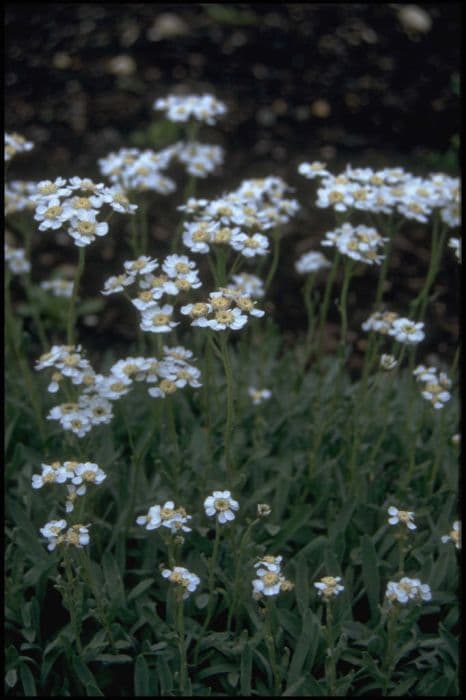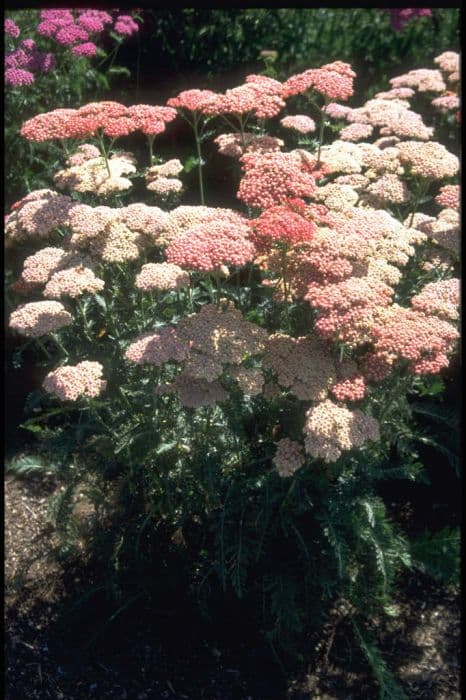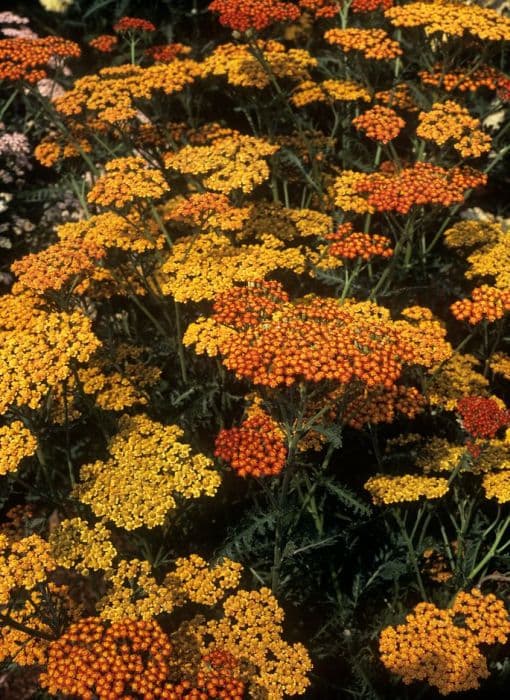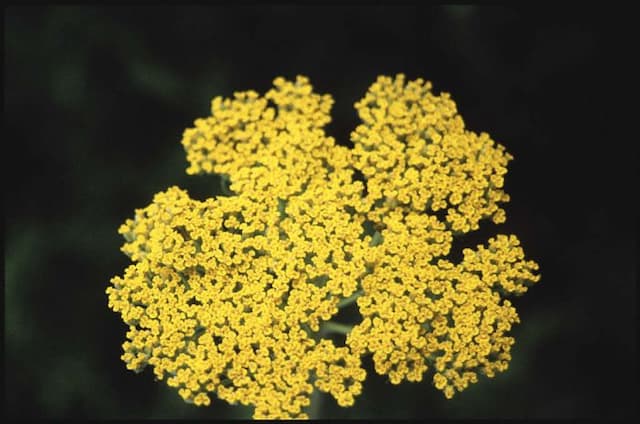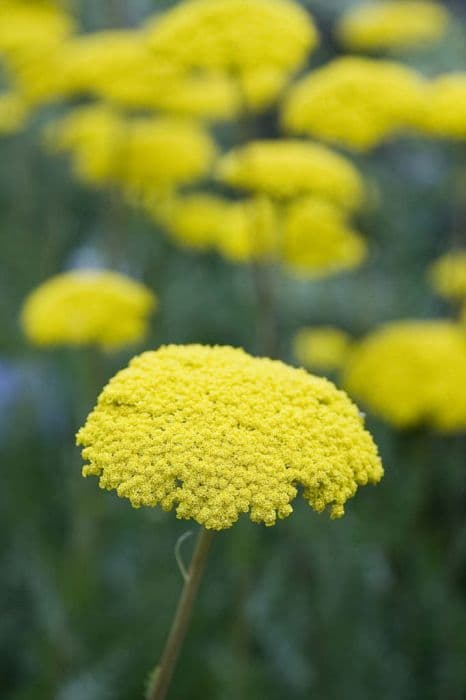Joe Pye Weed Eupatorium maculatum (Atropurpureum Group) 'Riesenschirm'

ABOUT
The plant known commonly as Joe Pye Weed 'Riesenschirm' is a striking perennial with a robust and bushy appearance. It features a sturdy, upright form with coarsely textured, lance-shaped leaves that boast a deep green hue. These leaves often arrange themselves in whorls around the thick, purplish-red stems, which add a touch of color to the foliage display. This plant is particularly known for its impressive flowers. Large, dome-shaped clusters of tiny, fluffy, mauve-pink flowers bloom profusely at the tops of the stems. These flower heads are quite dense and can add a significant visual impact to the garden. The blooms are a favorite of butterflies and other pollinators, which are frequently seen flitting around the plant, adding life and movement to its display. Overall, Joe Pye Weed 'Riesenschirm' has a commanding presence in any garden setting, with its combination of attractive foliage, vibrant stems, and showy flower crowns.
About this plant
 Names
NamesFamily
Asteraceae
Synonyms
Spotted Joe-Pye Weed, Purple Joe-Pye Weed, Joe-Pye Weed, Spotted Trumpet Weed, Purple Boneset
Common names
Eupatoriadelphus maculatus 'Riesenschirm', Eupatorium maculatum 'Riesenschirm'.
 Toxicity
ToxicityTo humans
Joe Pye Weed, specifically Eupatorium maculatum, can contain toxic compounds. However, its toxicity to humans is generally considered to be low, and significant effects from contact or ingestion are rare. If ingested in large quantities, some individuals may experience symptoms such as nausea, vomiting, diarrhea, or an allergic reaction. The plant is not widely regarded as a harmful species to humans, but care should be taken to avoid ingestion, especially by children or sensitive individuals, to prevent any potential discomfort or reaction.
To pets
Joe Pye Weed may also have low-level toxicity to pets if ingested. While typically not fatal, ingestion can potentially cause mild gastrointestinal upset, such as vomiting or diarrhea in animals. Because pets might be more sensitive or prone to eating large amounts of plant material, it's advisable to monitor their behavior around the plant and to prevent them from ingesting it. Nevertheless, it is not generally known for being a major toxic threat to pets compared to other more poisonous plants.
 Characteristics
CharacteristicsLife cycle
Perennials
Foliage type
Deciduous
Color of leaves
Green
Flower color
Pink
Height
5-7 feet (1.5-2.1 meters)
Spread
2-4 feet (0.6-1.2 meters)
Plant type
Herb
Hardiness zones
4
Native area
North America
Benefits
 General Benefits
General Benefits- Attracts Pollinators: Eupatorium maculatum 'Riesenschirm', commonly known as Joe Pye weed, is known for attracting butterflies and other beneficial insects to the garden.
- Wildlife Habitat: Provides food and habitat for various wildlife, including bees and birds.
- Aesthetic Appeal: Adds taller structure and visual interest to landscape designs with its lofty stems and showy mauve-pink flower clusters.
- Seasonal Interest: Its late summer bloom time provides color and interest in the garden when many other plants may be fading.
- Durability: Joe Pye weed is a hardy perennial that can tolerate a range of soil conditions and is relatively low maintenance once established.
- Easy Propagation: It can be easily propagated from seeds or division, allowing gardeners to expand their plantings or share with others.
- Naturalization: The plant is well-suited for naturalistic plantings and meadow gardens, contributing to biodiversity.
- Erosion Control: Its robust root system can help stabilize soil and prevent erosion, particularly useful in larger landscape areas or on slopes.
- Privacy Screen: Because of its height, Joe Pye weed can be used as a natural screen for added privacy in garden spaces.
 Medical Properties
Medical PropertiesThis plant is not used for medical purposes.
 Air-purifying Qualities
Air-purifying QualitiesThis plant is not specifically known for air purifying qualities.
 Other Uses
Other Uses- Joenaturous photography: The plant's striking appearance can provide an attractive backdrop or focal point for garden photography enthusiasts looking to capture the beauty of natural flora.
- Natural pest control: The presence of Eupatorium maculatum 'Riesenschirm' in a garden can attract predatory insects that help reduce the population of pests without the need for chemicals.
- Plant dye source: The leaves and flowers can be used to produce natural dyes for textiles, offering a range of colors depending on the mordant used.
- Educational tool: This plant can be used in educational settings to teach about plant biology, pollination, and ecosystem interactions as it readily attracts pollinators and demonstrates symbiotic relationships.
- Livestock forage: In some cases, when other food sources are scarce, the dried foliage of this plant could be used as emergency forage for livestock, though it's not the first choice due to potential toxicity.
- Windbreaks in rural landscapes: Tall and robust, these plants can be used in rural areas to create windbreaks that protect smaller, more delicate plants.
- Erosion control: The deep root system of Eupatorium maculatum 'Riesenschirm' helps to stabilize soil and can be used in areas prone to erosion.
- Decorative dried arrangements: The flowers and seed heads can be dried and added to bouquets or decorative arrangements for a long-lasting touch of nature indoors.
- Crafting: The stems and flowers of the plant can be used in crafting projects, such as making natural wreaths or other botanical crafts.
- Botanical illustration: Artists may use this plant as a subject for botanical illustration, capturing its detailed structure and beauty.
Interesting Facts
 Feng Shui
Feng ShuiJoe-Pye Weed is not used in Feng Shui practice.
 Zodiac Sign Compitability
Zodiac Sign CompitabilityJoe-Pye Weed is not used in astrology practice.
 Plant Symbolism
Plant Symbolism- Healing: Eupatorium has a history in herbal medicine, indicating a symbolic meaning of healing and health.
- Protection: Traditionally, some species of Eupatorium were used to ward off evil and disease, thus symbolizing protection.
- Overcoming challenges: The ability of Joe Pye Weed to thrive in difficult conditions can represent resilience and the ability to overcome adversity.
 Water
WaterJoe-Pye weed should be watered deeply, allowing the soil to become moderately moist but not waterlogged. During the growing season, provide approximately one to two inches of water per week, depending on the weather conditions—more frequent watering may be needed during periods of drought or extreme heat. Ensure that the plant receives a consistent amount of moisture, especially when the plant is establishing in its first year. Once established, Joe-Pye weed is relatively drought-tolerant, but regular watering will promote optimal growth and flowering.
 Light
LightJoe-Pye weed thrives in full sun to partial shade. The ideal spot for this plant is an area that receives at least six hours of direct sunlight daily, which will encourage the best flowering performance. While it can tolerate some shade, too little sun may lead to weak stems and poor flowering.
 Temperature
TemperatureJoe-Pye weed grows best in environments where the temperature ranges between 65 to 75 degrees Fahrenheit but can survive temperatures as low as down to around -30 degrees Fahrenheit. It is a hardy perennial that can withstand cold winters and bounce back in spring. The plant prefers warm summers but can also adapt to cooler summer conditions.
 Pruning
PruningPrune Joe-Pye weed in late winter or early spring before new growth begins. Cutting the plant back to about 18-24 inches will promote a bushier habit and robust flowering. Pruning is also a good time to remove any dead or damaged stems and to shape the plant. Joe-Pye weed may also be deadheaded after flowering to encourage a second bloom and prevent self-seeding, if desired.
 Cleaning
CleaningAs needed
 Soil
SoilJoe Pye Weed thrives in a moist, fertile soil with good drainage. The ideal soil pH range for this plant is between 6.0 and 7.0. A mix of loamy garden soil, compost, and peat or leaf mold can create the perfect environment for Joe Pye Weed to grow.
 Repotting
RepottingJoe Pye Weed, being a perennial that grows quite large, is often not repotted as it is usually planted directly in the garden. If grown in containers, repotting can be done every 2 to 3 years or when the plant outgrows its pot.
 Humidity & Misting
Humidity & MistingJoe Pye Weed prefers a high humidity environment, which mimics its natural habitat near streams or in moist meadows. While specific levels are not usually stipulated, ensuring the ambient humidity is consistently high will support its growth.
 Suitable locations
Suitable locationsIndoor
Provide ample light, moist soil, and high humidity.
Outdoor
Plant in moist soil, full sun or partial shade.
Hardiness zone
4-8 USDA
 Life cycle
Life cycleEupatorium maculatum 'Riesenschirm', commonly known as spotted joe-pye weed, begins its life as a seed, which, when sown in well-drained soil with adequate moisture, germinates in spring. As a perennial plant, it develops a robust root system and foliage in its first year, forming a rosette of leaves. In the following years, the plant sends up tall, sturdy stems during the growing season, topped with large domed clusters of mauve-pink flowers by mid to late summer, attracting pollinators such as butterflies. After flowering, it sets seed in late summer to fall, with seeds dispersing to produce new plants. In winter, the above-ground parts of 'Riesenschirm' die back, while the roots remain alive underground to enable the plant to regrow the next spring. Throughout its life, the plant may also spread vegetatively through its rhizomatous root system, forming larger clumps year after year.
 Propogation
PropogationPropogation time
Late summer
The most popular method of propagating the Joe-Pye weed 'Riesenschirm' is by division. This is typically done in the spring as new growth begins. To divide Joe-Pye weed, carefully unearth the plant and use a sharp spade to cut through the root ball, ensuring that each division has several shoots and a portion of the root system. Then, replant the divisions immediately at the same depth they were growing before and water them thoroughly. Divisions should be spaced about 18 to 24 inches apart (45 to 60 centimeters) to allow enough room for the plants to mature. This method allows for quick establishment of new plants that will resemble the parent plant and often produces flowers in the same growing season.
